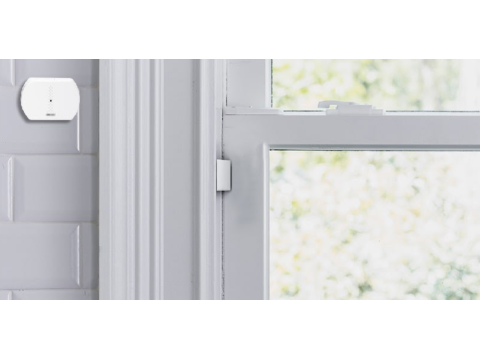Protecting windows against break-ins can be challenging—especially since intruders often focus on smashing or removing glass to gain access. Acoustic glass-break sensors detect the unique sound profile of shattering windows, triggering alarms at the first sign of forced entry. While older methods relied on “foil” tapes or direct-contact sensors, modern acoustic detectors offer sophisticated signal processing to reduce false alarms and enhance security. Below, we’ll explore their operating principles, installation tips, and how to integrate them into your broader alarm setup.
A Brief History of Glass-Break Detection
Early Methods: Foil and Impact Sensors
Foil “Tapes”
- Thin conductive strips adhered to window glass around the perimeter.
- Any crack or shatter that broke the foil caused an open circuit, triggering the alarm.
- Aesthetically unappealing and prone to damage from condensation or cleaning.
Impact (Shock-Contact) Sensors
- Attached directly to the glass.
- Reacted to significant vibrations, tilts, or hits.
- Common drawbacks included an obtrusive appearance and easy sabotage if left exposed.
Both methods eventually gave way to acoustic detectors, which “listen” for the characteristic sounds of breaking glass rather than requiring direct contact.
Acoustic Glass-Break Sensors: Modern Basics
Acoustic sensors pick up the low-frequency “thud” (initial impact) and the high-frequency “shatter” (tinkling of broken shards). Microprocessor-based signal processing helps differentiate real glass breakage from other noises like dishes clattering or doors slamming.
Key Parameters to Compare
- Detection Range (meters/feet)
- Often around 20 feet (~6 meters).
- Angle of Coverage
- Typically ~120° horizontally.
- Minimum Glass Size
- Some manufacturers specify the smallest windowpane area (e.g., 0.5–1 sq ft) the sensor can reliably protect.
While different brands market advanced features like multi-mode detection, test modes, and noise filtering, no acoustic sensor is foolproof against all noise scenarios. That said, installing them correctly—and pairing them with other security sensors—drastically lowers the risk of intrusions going unnoticed.
Note: Acoustic sensors cannot detect a glass pane that’s removed in one piece without breaking. Consider pairing them with magnetic contact sensors on the window frames to detect an opening attempt.
Installation Best Practices
Choose the Right Sensor
- Glass Type & Thickness: Check the manufacturer’s specs to ensure the device can detect breaks in laminated, tempered, or wired glass.
- Range & Coverage: Verify that the sensor’s maximum distance and angle accommodate your specific window layouts.
Positioning & Quantity
- Perimeter vs. Single Pane
- If drapes or curtains are absent, one sensor can cover multiple windows—assuming line of sight and distance limits are met.
- With heavy curtains, you may need to mount sensors closer to each window, possibly on the return wall (side of the window opening).
- Mounting Locations
- Walls, Ceilings, or Window Frames (the “soffit” or “reveal”).
- Avoid obstructed paths between the sensor and the glass.
- For large windows, you might need multiple sensors to ensure coverage.
Wiring & Connectivity
Acoustic glass-break detectors come in three varieties:
Wired (Non-Addressable)
- Typically require 4 conductors (2 for power, 2 for the alarm loop).
- E.g., 4-core security cable like KSPV-4 (popular in some regions).
Addressable Wired
- Connect via a 2-wire loop that carries both power and data.
- Common in large commercial addressable fire/security systems.
Wireless
- Communicate via radio frequency to the alarm panel’s receiver.
- Must match the panel’s wireless protocol (e.g., 433 MHz, 915 MHz, etc.) or brand-specific encrypted link.
Programming (Addressable & Wireless)
- Assign Unique IDs: Each sensor needs a unique address or identity.
- Zone & Partitioning: Group sensors into logical zones (e.g., “West Windows,” “2nd Floor Windows”) for easier monitoring and management.
- Calibration & Testing: Conduct real or simulated glass-break tests (many sensors have a “test mode” that detects a glass-break simulator or specific frequencies).
Use Cases & Complementary Detectors
Because an intruder might bypass or neutralize a glass-break sensor by removing the entire pane, professionals typically pair them with:
- Magnetic Contacts: Attached to window frames, trigger the alarm if the window is slid or swung open.
- Motion Detectors: Provide “layered” coverage in case an intruder manages to breach a window without breaking it or climbs in unnoticed.
- Vibration/Shock Sensors: Useful on very large panes or where regular acoustic noise might mask the sound of breaking glass.
Final Thoughts
Acoustic glass-break sensors form a crucial part of modern alarm setups. They’re less visually intrusive than legacy methods (e.g., foil tapes) and more flexible than direct glass-mounted shock sensors. Correctly selected and positioned, an acoustic detector can cover multiple windows at once—though heavy drapery, large rooms, and thick glass can reduce effective range.
Key Points:
- Always confirm your sensor’s range and angle against the real-world window layout.
- Pair acoustic sensors with motion detectors and door/window contacts for a robust, layered security strategy.
- Wired or wireless solutions each have pros and cons—choose according to your installation environment and budget.
For more insight into picking, installing, and programming glass-break sensors—and to find high-quality, tested products—visit safsale.com. Our team can help you devise an integrated security plan that keeps intruders at bay without sacrificing aesthetics or reliability.

